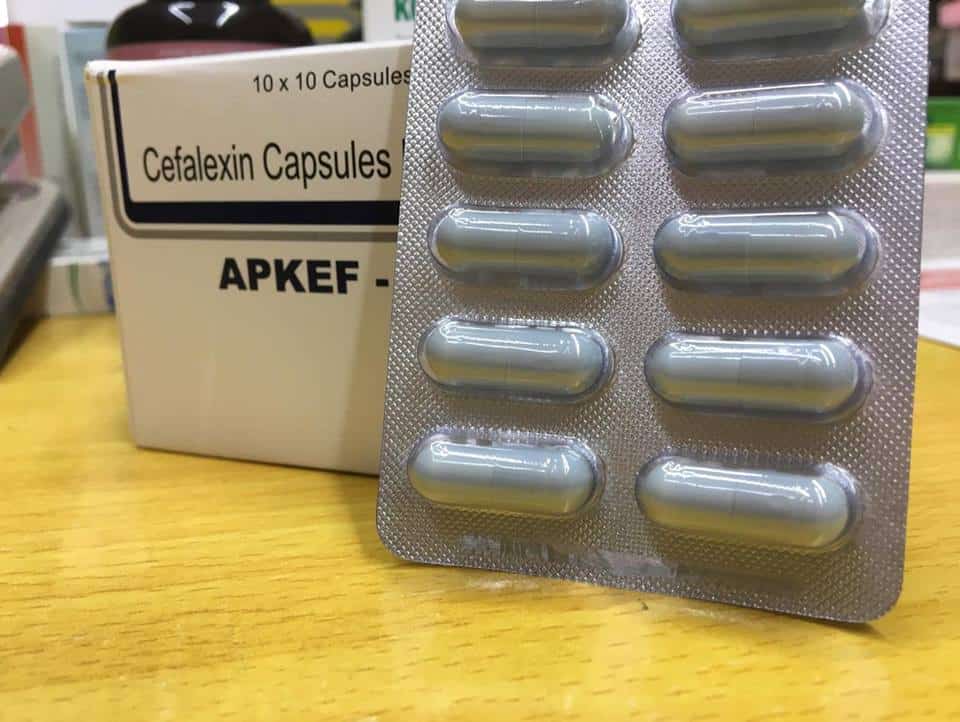keflex is an antibiotic that specializes in killing a certain type of bacteria called gram-positive bacteria while the bacteria that cause the UTI are gram-negative.
now Keflex (scientific name: cephalexin) can also work on the gram-negative bacteria but its activity on this type of bacteria is way less than it’s activity on the gram-positive bacteria.

before we continue our subject I just want to emphasize a very important question and that is why do we get a UTI?
there are many reasons for that but one of the most important reasons is having a poor immune system.
there is a way in which we can strengthen our immune system and that is by taking vitamins and minerals supplements in addition to eating healthy food that contains a lot of salad.
centrum is a multivitamin & multimineral supplement that contains all the vitamins and minerals needed to strengthen our body against infections like the UTI.
take centrum silver if you are above 55 years of age.
take one tablet of centrum or centrum silver after meal once daily, check their prices on amazon.
now back to our cephalexin (Keflex) subject.
people take the whole course of Keflex (which we will talk about it later) and they go to the doctor, the doctor tells them to take a urinalysis test or a urine culture test or whatever then they give the results to the doctor and the doctor tells them that their tests show that the bacteria had been eliminated and the UTI is cured.
and then after a month or some period of time, the symptoms of the UTI comeback and they return to the doctor to see that the infection has recurred.
didn’t the Keflex kill the bacteria before so why it’s returning now?
well, that’s partly true because the Keflex may kill some of the bacteria that are in your urinary tract but there will be still some bacteria that is maybe dormant or maybe hiding or most likely the numbers of the bacteria that is in your urinary tract are reduced by the actions of Keflex but Keflex didn’t get rid of them all but they are still there it’s just their numbers aren’t so big to show up in the urine test.
because the amount of the bacteria in your urinary tract must reach up to a certain point before it can show in the urine so the Keflex might not kill all the bacteria but it still won’t show in the urine and that may cause you a recurrent UTI and then curing this UTI might even be harder than it was in the beginning.
remember when you use an antibiotic the goal must be to eliminate the bacteria completely not a trace of the bacteria must be present after you finish the complete course of that antibiotic.
using a weak antibiotic or an antibiotic that does not work specifically on the type of bacteria that cause the UTI like Keflex (cephalexin) can backfire and the results might be even worse than not using any antibiotic at all.
the bacterial resistance to antibiotics is a problem that is growing worldwide, choosing an antibiotic like Keflex to treat bacterial infections like urinary tract infections (UTI) might contribute to this problem because as I said Keflex won’t treat the bacteria that cause the UTI efficiently and won’t eliminate the bacteria completely, and the remaining bacteria will be stronger and it’s resistance to antibiotics could be bigger, and that might cause you a bigger problem which is called recurrent UTI.
keflex cannot be used for prophylaxis from the uti.
in other words, do not use Keflex for the prevention of uti.
that means if you have cured the UTI and the doctor told you that you officially do not have a UTI then if at some time you decided to take the next step to prevent the UTI from happening again do not use Keflex for that purpose.
when using Keflex (cephalexin) to prevent UTI bacterial resistance can occur and the UTI can return.
the bacteria that cause the UTI are in most cases E. coli, other types might include Klebsiella, Pseudomonas, and the fungi Candida albicans.
ps: the chlamydia and Neisseria gonorrhoeae bacteria that are mostly transmitted after sex with an infected partner mostly invade the urethra not the bladder causing a condition that is called urethritis, not UTI.
it’s worth mentioning that Keflex works poorly on all of the aforementioned types of bacteria including chlamydia and Neisseria gonorrhoeae.
not that it won’t work on them like ever, but it just won’t eradicate them completely but Keflex is still better than amoxicillin in treating the UTI though.
now if you decided for some reason to use Keflex to treat the UTI that you have how many capsules should you take per day and for how many days? or in other words what is the dose of Keflex (cephalexin) for UTI?
these are the adults’ doses: take one 500 mg Keflex (cephalexin) capsule 4 times daily or every 6 hours for 7 to 14 days.
do not use Keflex for prophylaxis against the UTI even if you take it in high or low doses because that will yield the same results which is bacterial resistance and maybe the recurrence of the UTI.
note: for prophylaxis from the UTI you should use other solutions like probiotics, cranberry juice, and lifestyle changes
note: some researches indicate that taking 1000 mg of Keflex 2 times daily or every 12 hours gave the same results as taking 500 mg of Keflex 4 times daily or every 6 hours.
the dose of Keflex for pediatrics suffering from uti is
less than 15 years: 25-50 mg/kg/day divided in 4 doses for 10 days, meaning if a child weighs 10 kg and the doctor decided to give him 30 mg/kg/day then the dose for him is 300 mg per day and when you divide then in four doses (ever 6 hours) then the doctor will give him 75 mg every 6 hours for 10 days.
more than 15 years: the child more than 15 should take one 250 mg Keflex capsule 4 times daily for 10 days. keep in mind that if you have penicillin allergy you should consult your doctor before taking Keflex to treat the UTI or any other condition because about 10 percent of the people who have penicillin allergy can have cross-sensitivity to Keflex. so, consult your doctor before you take Keflex if you have a penicillin allergy.
pregnant women suffering from UTI are safe to use Keflex to treat the UTI, no harm has been shown for the pregnant women who take Keflex also the use of Keflex in breastfeeding women are generally safe but still any pregnant woman must consult the doctor before taking any medication.
keflex can be used to treat the mild cases of UTI in elderly patients but it’s not the first choice. while most of the elder patients have their liver and kidney function at a lower rate from young people, adjustment of the dose of Keflex is required because the liver and kidneys in old patients may not tolerate high doses of Keflex.
so, the dose can be 250 mg of Keflex twice daily or even once daily. do not use Keflex for prophylaxis against UTI in elderly patients also.
keflex cannot be used to prevent future UTI in elderly patients, in fact, that can make things worse as the bacterial resistance can grow and the symptoms for recurrent UTI can happen again, and treating it would be even harder than if you do not use Keflex at all.
when taking Keflex the following side effects might occur if you notice any of them report to your doctor immediately:
abdominal pain diarrhea vomiting dyspepsia or indigestion the frequency of these side effects may increase if you take Keflex on an empty stomach so always make sure that you take Keflex after meals.
these are the side effects that occur in the gastrointestinal tract these side effects are also shared by the drugs which are similar to Keflex which come from the same family ( first generation cephalosporins) like cefadroxil and cefazolin and also, these side effects are found in the antibiotics from the penicillin family like amoxicillin, ampicillin, methicillin, and others. all of these antibiotics share those abdominal side effects.
other side effects of Keflex include: – agitation – confusion- fatigue – headache – dizziness – urticaria – vaginal discharge – hypersensitivity (especially if the patient already has an allergy to penicillin, that can make him or her more susceptible to having hypersensitivity from Keflex)- bacterial resistance (can occur with misuse of Keflex).
keep healthy and see you in my next article.
by the way, I am not a native English language speaker so excuse me if I make any mistakes.
